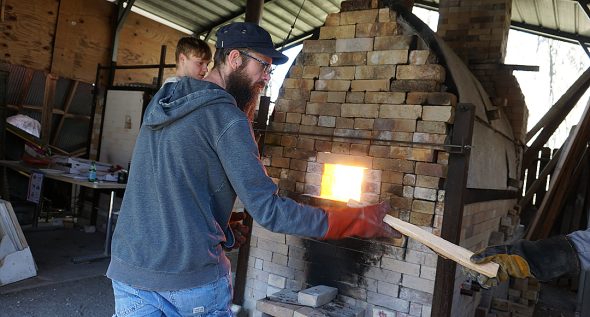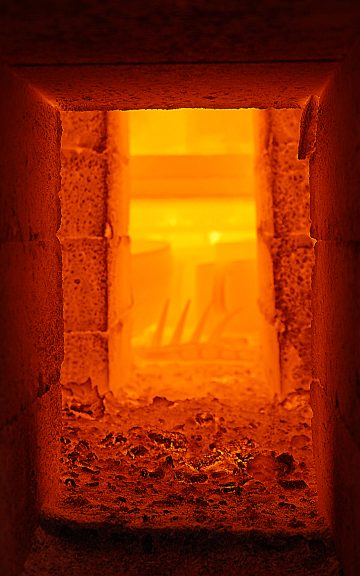
Longtime kiln master Brad Husk feeds a nearly 2,300-degree blaze in the final firing of John Bryan Community Pottery’s 14-year-old wood kiln. (Photo by Lauren "Chuck" Shows)
Farewell to a kiln, and its master
- Published: March 28, 2024
With paper cranes folded by his children nestled as tinder among a stack of wood, on Friday, March 15, Brad Husk struck a flame and set the paper wings alight.
That flame would later become a roaring blaze that burned for 24 hours, and marked the final firing of the John Bryan Community Pottery wood kiln — and the end of an era for the local pottery collective.
Husk, a local resident, pottery artist and kiln master, told the News last week that a wood kiln — built with heat-resistant bricks in an elegant arch — can typically handle about 100 firings. The John Bryan kiln, built in 2010, has lasted for about 120 firings.
“It’s starting to fail structurally in a few different ways,” Husk said.
As studio manager for the nonprofit John Bryan Community Pottery from 2017 until last year — and studio technician for several years before that — Husk has been present for most of the firings of the 40-cubic-foot kiln. Before he became kiln master, the kiln was overseen by Husk’s wood-firing mentor and former Community Pottery studio technician, Geno Luketic, who built it.
Continuously feeding the hungry blaze of a wood kiln firing requires about a cord-and-a-half — roughly 5,000 pounds — of wood, most of which Husk said he collects and dries himself in preparation. Depending on the type of tree from which it came, it can take anywhere from six months to two years for wood to be properly dried.
It also requires round-the-clock supervision and stoking over 24 hours to reach and maintain an ideal temperature. At its peak, Husk said, the kiln reaches 2,300–2,400 degrees Fahrenheit. The temperature inside the kiln is measured by both a digital pyrometer and pyrometric cones — sets of four thin, ceramic pyramids that melt at different temperatures. The kiln and the shed that houses it are decorated with scores of spent pyrometric cones, bent in delicate wave-like patterns — a physical record of more than a decade of wood firings.
Husk and several other Community Pottery members were on hand when Husk lit the first pile of wood Friday night. When the News returned the next afternoon, a new group of members were there assisting Husk, who, except for a brief break for a couple hours of sleep, had been there all through the night and into Saturday.

Photo by Lauren “Chuck” Shows
By then, the entire kiln was radiating heat, and Husk continuously called out the temperature reading on the digital pyrometer — 2,100 degrees, then 2,170, then 2,200. It took a rotating team of three to stoke the kiln’s fire every five minutes or so — one person to open the kiln’s door, one to hand over wood piece by piece, and one to feed the wood into the fire.
Each time Husk and his crew opened the kiln door, the fire was so bright it was difficult to look at directly, and so hot that the person stoking it invariably came away with a pink face, as though they’d been out in the sun a bit too long.
“When you start a wood firing, it’s like getting on a ship — you’re not getting off until you get there,” Husk said in a lull between stoking. “It’s like the only thing that exists is this thing that we’re doing — like throwing clay on the wheel. The rest of the world just kind of falls away.”
The wood the members of Community Pottery fed into the kiln wouldn’t only serve as fuel, Husk said. As it burned, molten ash and volatile salts and sugars from the wood would settle onto the 300 or so pots and mugs and other items inside, creating flecks and sheens in unpredictable, but beautiful patterns. Those patterns would also be affected by where the pottery was situated within the kiln, which is hottest right at the front.
“Think of the pots like rocks in a stream — the flame is deflecting, moving through the pots,” Husk said. “The very front is kind of high-risk, high-reward — you may lose it entirely. Or it might be so much better than you ever thought it could be.”
In other words, to be a potter is also to be a practitioner of patience amid process, and acceptance of outcome, whatever that might be.
With that philosophy in mind, Husk said the final wood kiln firing also marks the end of his time as kiln master for John Bryan Community Pottery. At the end of March, he’ll move to focusing on his own pottery business from home, where he maintains a smaller wood kiln.
Husk said he had originally hoped he could build a new wood kiln after the current one is deconstructed, but realized no one else would be able to take over as kiln master in his stead.
“This type of firing is very challenging, and hard to teach,” he said. “You have to be there, be there, be there. It became apparent that the right person to do that wasn’t around.”
He added that John Bryan Community Pottery aims to replace the wood kiln with a gas-fired soda kiln in the future. The soda kiln, he said, with its more consistent heat source, won’t require the kind of constant work a wood kiln does, but will produce similar results via the addition of baking soda during the firing process. Studio manager Meg Smallwood told the News a timeline for acquiring the new kiln has yet to be established, but the pottery collective will begin fundraising for the new soda kiln in the near future.
Husk said that, though he intends to maintain a presence around John Bryan Community Pottery, his departure as kiln master is bittersweet. Still, he looked at his exit through the eyes of a potter.
“I feel like pottery has helped me cope with life in some ways,” he said. “You have to be willing to let go.”
For more information on John Bryan Community Pottery, or to donate to the nonprofit, go to communitypottery.com.
The Yellow Springs News encourages respectful discussion of this article.
You must login to post a comment.
Don't have a login? Register for a free YSNews.com account.















No comments yet for this article.